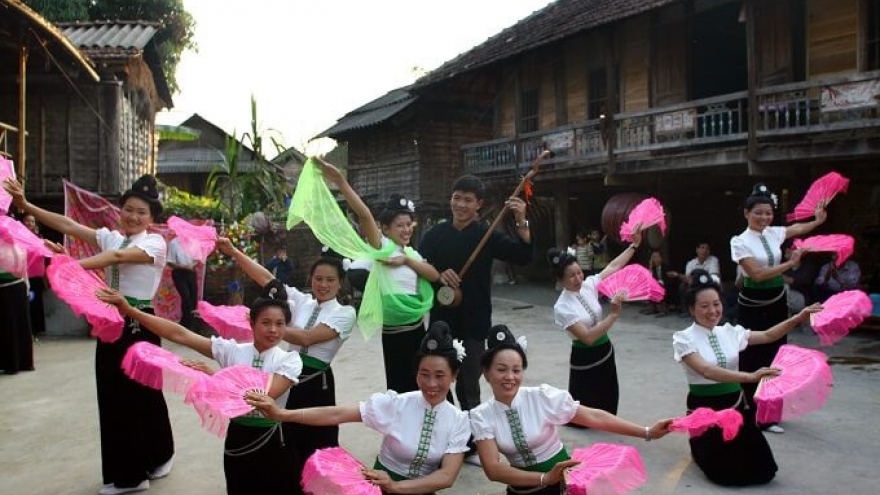Pieu scarf in Thai ethnic people’ life
Sunday, 09:38, 03/11/2019
VOV.VN - The Thai ethnic’s Pieu scarf embodies social and spiritual values.
 |
| A Pieu scarf is an indispensable item of Thai ethnic women among their many accessories. It keeps them warm in winter and shields them from the scorching heat in summer. |
 |
| Pieu scarves keep Thai women’s hair tidy and untangled while they are working in the field, climbing mountains to collect vegetables, or doing housework. |
 |
| Thai women often cover their heads with a colorful Pieu scarf as an added bit of charm in their traditional Thai attires. |
 |
| Thai Pieu scarves are woven from cotton cloth and then dyed several times to a dark indigo color. A Pieu scarf is often 40 cm in width and 1.6 meter in length, with beautiful embroidered motifs at either end. |
 |
| Pieu scarves are embroidered with colorful silky threads. There are two types of “Pieu” scarf: “Pieu xon” and “Pieu xeo”. “Pieu xon” is simply embroidered with intertwined colorful, silky threads and popular motifs in the shape of trees, diamonds, and flowers. Meanwhile, Pieu “xeo” is intricately embroidered with colorful threads at the ends of the scarf. |
 |
| Popular motifs on the Pieu scarf are embroidered intricately in a diamond shape which is considered a symbol of luck and sustainability by Thai ethnic people. Colors on the Pieu scarf represent fidelity between husband and wife. |
 |
| A Thai girl often prepares up to 30 Pieu scarves as gifts for her future husband’s relatives. Motifs embroidered on Pieu scarves reflect the girl’s skill. |
 |
| Upon finishing embroidering, Thai women use red or green pieces of cloth for the scarves’ outer edges and decorate with circle buds (similar to Khau Cut symbol on the roof of Thai people’s houses) which are supposed to drive evil away. Each scarf tells a story through its patterns and colors and reflects the owner’s character and mindset. |
 |
| Circle buds are made from rolled pieces of red cloth in the shape of the peak of ferns trees with green, red, purple and yellow threads intertwined. |
 |
| There’s a big difference between the Pieu scarves of Black and White Thai women. While those of White Thai women are without circle buds and have simple embroidered motifs often in the shape of trees.... Pictured is the symbol “ta leo” thought to drive away evil and protect the souls of those who wear the scarves. |
 |
| When a person dies, anywhere from 4 to 8 Pieu are prepared for the deceased at his or her funeral. On the death of one of the two spouses, a Pieu is cut in two, and one of the halves is used to cover the face of the deceased person. The other person will keep the remaining half until the end of his or her life. At the time of his or her death, this half will be used to cover his or her face. That way, the couple will be able to meet in the other world. |
 |
| Pieu is an indispensable item in music and art performances, especially in Thai people’s traditional Xoe dances. A boy often reaches for the Pieu scarf of the girl he likes as a way to show his love at festivals. |
 |
| In the past, any boy who catches a cloth ball thrown by a girl will have to give her a pair of silver wristlaces while the girl must give him her Pieu scarf. The scarf signals their joining together and falling in love. If the girl does not like the boy, she will give him something else to get her scarf back. |
 |
| As the society develops with a more modern wardrobe, it’s more difficult for Thai ethnic people to preserve their traditional attire. However, Pieu scarves still play an indispensable part in Thai ethnic people’s spiritual lives. |

